A New Measure for an Acceptable Level of Homogeneity in Meta-Informatics
Abstract
1. Introduction
Motivation
2. Methods
2.1. Visualization of the Dynamics of the Higgins Score
2.2. Visualization of the Dynamics of the Birge Ratio
2.3. Visualization of the Dynamics of the Score
2.4. Visualization of the Dynamics of the Interrelations Among the Scores
3. Elasticity Score: A Measure of Comparison
Visualizations of the Dynamics of the Elasticities , and
4. Application and Results
- Step 1.
- Scan and select peer-reviewed mental-health journal meta-analysis articles in the literature using Google Scholar Search. Please note that the articles do not display the data.
- Step 2.
- Read the inference in each article and take notes on whether the meta-analysis indicates the existence of heterogeneity or homogeneity using the Higgins I2 score, the Cochran Q score, or the Birge H2 score.
- Step 3.
- Utilize the 287 inferences and their corresponding Higgins I2, Cochran Q, or H2 scores in calculating the S2 score and the integrated elasticity Higgins I2 score, Birge H2 score, and S2 score.
5. Discussion
6. Conclusions
Author Contributions
Funding
Data Availability Statement
Conflicts of Interest
References
- Glass, G.V. Primary, secondary, and meta-analysis of research. Educ. Res. 1976, 5, 3–8. [Google Scholar] [CrossRef]
- Abuyadek, R.M.; Hammouda, E.A.; Elrewany, E.; Elmalawany, D.H.; Ashmawy, R.; Zeina, S.; Gebreal, A.; Ghazy, R.M. Acceptability of Tele-mental Health Services Among Users: A Systematic Review and Meta-analysis. BMC Public Health 2024, 24, 1143. [Google Scholar] [CrossRef]
- An, T.; Sun, H.; Yuan, L.; Wu, X.; Lu, B. Associations of anxiety and depression with restless leg syndrome: A systematic review and meta-analysis. Front. Neurol. 2024, 15, 1366839. [Google Scholar] [CrossRef]
- Ashraf, F.; Mustafa, M.S.; Shafique, M.A.; Haseeb, A.; Mussarat, A.; Noorani, A.; Iqbal, J. Association between depression and stroke risk in adults: A systematic review and meta-analysis. Front. Neurol. 2024, 15, 1331300. [Google Scholar] [CrossRef] [PubMed]
- Barry, R.; Anderson, J.; Tran, L.; Bahji, A.; Dimitropoulos, G.; Ghosh, S.M.; Kirkham, J.; Messier, G.; Patten, S.B.; Rittenbach, K.; et al. Prevalence of mental health disorders among individuals experiencing homelessness: A systematic review and Meta-analysis. JAMA Psychiatry 2024, 81, 691–699. [Google Scholar] [CrossRef] [PubMed]
- Booth, A.; Noyes, J.; Flemming, K.; Gerhardus, A.; Wahlster, P.; van der Wilt, G.J.; Mozygemba, K.; Refolo, P.; Sacchini, D.; Tummers, M.; et al. Guidance on Choosing Qualitative Evidence Synthesis Methods for Use in Health Technology Assessments of Complex Interventions. 2016. Available online: http://www.integrate-hta.eu/downloads/ (accessed on 11 April 2025).
- Grant, M.J.; Booth, A. A typology of reviews: An analysis of 14 review types and associated methodologies. Health Inf. Libr. J. 2009, 26, 91–108. [Google Scholar] [CrossRef] [PubMed]
- Fekadu Dadi, A.; Miller, E.R.; Mwanri, L. Antenatal depression and its association with adverse birth outcomes in low and middle-income countries: A systematic review and meta-analysis. PLoS ONE 2020, 15, e0227323. [Google Scholar] [CrossRef]
- Gao, P.; Cai, S.; Liu, Q.; Du, M.; Liu, J.; Liu, M. Effectiveness and safety of SARS-CoV-2 vaccines among children and adolescents: A systematic review and meta-analysis. Vaccines 2022, 10, 421. [Google Scholar] [CrossRef]
- Gao, P.; Kang, L.Y.; Liu, J.; Liu, M. Immunogenicity, effectiveness, and safety of COVID-19 vaccines among children and adolescents aged 2–18 years: An updated systematic review and meta-analysis. World J. Pediatr. 2023, 19, 1041–1054. [Google Scholar] [CrossRef]
- Gao, P.; Liu, J.; Liu, M. Effect of COVID-19 vaccines on reducing the risk of long COVID in the real world: A systematic review and meta-analysis. Int. J. Environ. Res. Public Health 2022, 19, 12422. [Google Scholar] [CrossRef]
- Ghafari, M.; Bahadivand-Chegini, S.; Nadi, T.; Doosti-Irani, A. The global prevalence of dental healthcare needs and unmet dental needs among adolescents: A systematic review and meta-analysis. Epidemiol. Health 2019, 41, e2019046. [Google Scholar] [CrossRef] [PubMed]
- Harris, C.; Hedges, L.; Valentine, J. Handbook of Research Synthesis and Meta-Analysis; Russell Sage Foundation: New York, NY, USA, 2009. [Google Scholar]
- Islam, M.M.; Yunus, M.Y.; Akib, M.S.; Iqbal, M.R.; Khan, M. Prevalence of COVID-19 vaccine hesitancy in South Asia: A systematic review and meta-analysis. J. Popul. Soc. Stud. 2023, 31, 587–611. [Google Scholar] [CrossRef]
- Petrocchi, N.; Ottaviani, C.; Cheli, S.; Matos, M.; Baldi, B.; Basran, J.K.; Gilbert, P. The impact of compassion-focused therapy on positive and negative mental health outcomes: Results of a series of meta-analyses. Clin. Psychol. Sci. Pract. 2023, 31, 230–247. [Google Scholar] [CrossRef]
- Pigott, T.D. Advances in Meta-Analysis; Springer: New York, NY, USA, 2012. [Google Scholar]
- Prabhod, K.J. The Role of Artificial Intelligence in Reducing Healthcare Costs and Improving Operational Efficiency. Q. J. Emerg. Technol. Innov. 2024, 9, 47–59. [Google Scholar]
- Shen, H.; Xie, J.; Li, J.; Cheng, Y. The correlation between scientific collaboration and citation counts at the paper level: A meta-analysis. Scientometrics 2021, 126, 3443–3470. [Google Scholar] [CrossRef]
- Shanmugam, R.; Singh, K.P. Practicing Meta-Analytics with Rectification. Publications 2025, 13, 2. [Google Scholar] [CrossRef]
- Shanmugam, R.; Tabatabai, M.; Wilus, D.; Singh, K.P. The bounds of meta-analytics and an alternative method. Epidemiol. Health 2024, 46, e2024016. [Google Scholar] [CrossRef] [PubMed]
- Gogtay, N.J.; Thatte, U.M. An introduction to meta-analysis. J. Assoc. Physicians India 2017, 65, 78–85. [Google Scholar]
- Higgins, J.P.; Thompson, S.G. Quantifying heterogeneity in a meta-analysis. Stat. Med. 2002, 21, 1539–1558. [Google Scholar] [CrossRef]
- Deeks, J.J.; Bossuyt, P.M.; Leeflang, M.M.; Takwoingi, Y. (Eds.) Cochrane Handbook for Systematic Reviews of Diagnostic Test Accuracy; John Wiley & Sons: Hoboken, NJ, USA, 2023. [Google Scholar]
- Higgins, J.P.; Thompson, S.G.; Deeks, J.J.; Altman, D.G. Measuring inconsistency in meta-analyses. BMJ 2003, 327, 557–560. [Google Scholar] [CrossRef]
- Borenstein, M.; Higgins, J.P.; Hedges, L.V.; Rothstein, H.R. Basics of meta-analysis: I2 is not an absolute measure of heterogeneity. Res. Synth. Methods 2017, 8, 5–18. [Google Scholar] [CrossRef] [PubMed]
- Birge, R.T. The calculation of errors by the method of least squares. Phys. Rev. 1932, 40, 207. [Google Scholar] [CrossRef]
- Isonne, C.; Iera, J.; Sciurti, A.; Renzi, E.; De Blasiis, M.R.; Marzuillo, C.; Villari, P.; Baccolini, V. How well does vaccine literacy predict intention to vaccinate and vaccination status? A systematic review and meta-analysis. Hum. Vaccines Immunother. 2024, 20, 2300848. [Google Scholar] [CrossRef] [PubMed]
- Naeimi, R.; Sepidarkish, M.; Mollalo, A.; Parsa, H.; Mahjour, S.; Safarpour, F.; Rostami, A. SARS-CoV-2 seroprevalence in children worldwide: A systematic review and meta-analysis. Eclinical Med. 2023, 56, 101786. [Google Scholar] [CrossRef]
- Özgüç, S.; Kaplan Serin, E.; Tanriverdi, D. Death anxiety associated with coronavirus (COVID-19) disease: A systematic review and meta-analysis. OMEGA-J. Death Dying 2024, 88, 823–856. [Google Scholar] [CrossRef]
- Pauley, D.; Cuijpers, P.; Papola, D.; Miguel, C.; Karyotaki, E. Two decades of digital interventions for anxiety disorders: A systematic review and meta-analysis of treatment effectiveness. Psychol. Med. 2023, 53, 567–579. [Google Scholar] [CrossRef]
- Agbokou, K. On the Nature of Elasticity Function: An Investigation and a Kernel Estimation. J. Appl. Math. 2023, 2023, 1346602. [Google Scholar] [CrossRef]
- Veres-Ferrer, E.J.; Pavía, J.M. Properties of the elasticity of a continuous random variable. A special look at its behavior and speed of change. Commun. Stat.-Theory Methods 2017, 46, 3054–3069. [Google Scholar] [CrossRef]
- Veres-Ferrer, E.J.; Pavía, J.M. Elasticity as a measure for online determination of remission points in ongoing epidemics. Stat. Med. 2021, 40, 865–884. [Google Scholar] [CrossRef]
- Veres-Ferrer, E.J.; Pavía, J.M. The Elasticity of a Random Variable as a Tool for Measuring and Assessing Risks. Risks 2022, 10, 68. [Google Scholar] [CrossRef]
- Bütikofer, A.; Ginja, R.; Karbownik, K.; Landaud, F. (Breaking) intergenerational transmission of mental health. J. Hum. Resour. 2024, 59, S108–S151. [Google Scholar] [CrossRef]
- Chandra, R. Alfred Marshall (1842–1924). In Reflections on the Future of Capitalism: From Karl Marx to Amartya Sen; Springer International Publishing: Cham, Switzerland, 2024; pp. 217–256. [Google Scholar]
- Meng, L.; Mao, S.; Lin, J. Heterogeneous elasticity drives ripening and controls bursting kinetics of transcriptional condensates. Proc. Natl. Acad. Sci. USA 2024, 121, e2316610121. [Google Scholar] [CrossRef] [PubMed]
- Jin, Y.; Sun, T.; Zheng, P.; An, J. Mass quarantine and mental health during COVID-19: A meta-analysis. J. Affect. Disord. 2021, 295, 1335–1346. [Google Scholar] [CrossRef]
- Li, J.; Yin, J.; Waqas, A.; Huang, Z.; Zhang, H.; Chen, M.; Li, X. Quality of life in mothers with perinatal depression: A systematic review and meta-Analysis. Front. Psychiatry 2022, 13, 734836. [Google Scholar] [CrossRef] [PubMed]
- Li, S.N.; Chien, W.T.; Lam, S.K.K.; Chen, Z.Y.; Ma, X. Effectiveness of parent-focused interventions for improving the mental health of parents and their children with autism spectrum disorder: A systematic review and meta-analysis. Res. Autism Spectr. Disord. 2024, 114, 102389. [Google Scholar] [CrossRef]
- Rajkumar, E.; Julia, G.J.; Sri Lakshmi, K.N.V.; Ranjana, P.K.; Manjima, M.; Devi, R.R.; Jacob, A.M. Prevalence of mental health problems among rural adolescents in India: A systematic review and meta-analysis. Sci. Rep. 2022, 12, 16573. [Google Scholar] [CrossRef]
- Restoy, D.; Oriol-Escudé, M.; Alonzo-Castillo, T.; Magán-Maganto, M.; Canal-Bedia, R.; Díez-Villoria, E.; Lugo-Marín, J. Emotion regulation and emotion dysregulation in children and adolescents with autism spectrum disorder: A meta-analysis of evaluation and intervention studies. Clin. Psychol. Rev. 2024, 109, 102410. [Google Scholar] [CrossRef]
- Rodrigues, B.; Encantado, J.; Franco, S.; Silva, M.N.; Carraça, E.V. Psychosocial correlations of physical activity in cancer survivors: A systematic review and meta-analysis. J. Cancer Surviv. 2024; 1–18, Online ahead of print. [Google Scholar] [CrossRef]
- Rosenbaum, D.A. The Cinderella of psychology: The neglect of motor control in the science of mental life and behavior. In Cognitive Control of Action; Routledge: London, UK, 2024; pp. 136–155. [Google Scholar]
- Wang, L.; Liang, C.; Chen, P.; Cao, Y.; Zhang, Y. Effect of antidepressants on psychological comorbidities, disease activity, and quality of life in inflammatory bowel disease: A systematic review and meta-analysis. Ther. Adv. Gastroenterol. 2023, 16, 17562848231155022. [Google Scholar] [CrossRef]
- Xiong, W.; Wang, D.; Ren, W.; Liu, X.; Wen, R.; Luo, Y. The global prevalence of and risk factors for fear of falling among older adults: A systematic review and meta-analysis. BMC Geriatr. 2024, 24, 321. [Google Scholar] [CrossRef]
- Yeo, G.; Tan, C.; Ho, D.; Baumeister, R.F. How do aspects of selfhood relate to depression and anxiety among youth? A meta-analysis. Psychol. Med. 2023, 53, 4833–4855. [Google Scholar] [CrossRef]
- Zhang, Q.; Wu, G.; Chen, J.; Fang, K.; Liu, Q.; Zhang, P.; Zhang, C. Factors influencing depressive symptoms in Chinese female breast cancer patients: A meta-analysis. Front. Psychol. 2024, 15, 1332523. [Google Scholar] [CrossRef]
- Zhang, Z.; Hu, Y.; Liu, S.; Feng, X.; Yang, J.; Cheng, L.J.; Wu, X.V. The effectiveness of e-mental health interventions on stress, anxiety, and depression among healthcare professionals: A systematic review and meta-analysis. Syst. Rev. 2024, 13, 144. [Google Scholar] [CrossRef] [PubMed]
- Mansouri, M.; Naghshi, S.; Parsaeian, M.; GSepanlou, S.; Poustchi, H.; Momayez Sanat, Z.; Pourshams, A. Opium Use and Cancer Risk: A Comprehensive Systematic Review and Meta-Analysis of Observational Studies. Int. J. Clin. Pract. 2022, 2022, 5397449. [Google Scholar] [CrossRef] [PubMed]
- Niu, C.; Li, P.; Du, X.; Zhao, M.; Wang, H.; Yang, D.; Jing, W. Risk factors for anxiety in patients with epilepsy: A meta-analysis. Epilepsy Behav. 2024, 153, 109665. [Google Scholar] [CrossRef]
- O’Dea, G.A.; Youssef, G.J.; Hagg, L.J.; Francis, L.M.; Spry, E.A.; Rossen, L.; Macdonald, J.A. Associations between maternal psychological distress and mother-infant bonding: A systematic review and meta-analysis. Arch. Women’s Ment. Health 2023, 26, 441–452. [Google Scholar] [CrossRef] [PubMed]
- Siskind, D.; Gallagher, E.; Winckel, K.; Hollingworth, S.; Kisely, S.; Firth, J.; Marteene, W. Does switching antipsychotics ameliorate weight gain in patients with severe mental illness? A systematic review and meta-analysis. Schizophr. Bull. 2021, 47, 948–958. [Google Scholar] [CrossRef]
- Soheili, M.; Khateri, S.; Moradpour, F.; Mohammadzedeh, P.; Zareie, M.; Mortazavi, S.M.M.; Moradi, Y. The efficacy and effectiveness of COVID-19 vaccines around the world: A mini-review and meta-analysis. Ann. Clin. Microbiol. Antimicrob. 2023, 22, 42. [Google Scholar] [CrossRef]
- Tng, G.Y.; Koh, J.; Soh, X.C.; Majeed, N.M.; Hartanto, A. Efficacy of digital mental health interventions for PTSD symptoms: A systematic review of meta-analyses. J. Affect. Disord. 2024, 357, 23–36. [Google Scholar] [CrossRef]
- Varghese, A.; George, G.; Kondaguli, S.V.; Naser, A.Y.; Khakha, D.C.; Chatterji, R. Decline in the mental health of nurses across the globe during COVID-19: A systematic review and meta-analysis. J. Glob. Health 2021, 11, 05009. [Google Scholar] [CrossRef]
- Ye, Z.; Li, W.; Zhu, R. Online psychosocial interventions for improving mental health in people during the COVID-19 pandemic: A systematic review and meta-analysis. J. Affect. Disord. 2022, 316, 120–131. [Google Scholar] [CrossRef]
- Zhu, X.; Chen, Y. Does price negotiation in China bring high-value novel drugs to the national medical insurance beneficiaries. Health Policy Technol. 2025, 14, 100963. [Google Scholar] [CrossRef]
- Perrot, A.; Compagnucci, F.; Veneri, P. Science & Economic Geography; ResearchGate: Berlin, Germany, 2025. [Google Scholar]
- Bonett, D.G. An Introduction to Meta-Analysis; University of California: Santa Cruz, CA, USA, 2017. [Google Scholar]
- Caffieri, A.; Gómez-Gómez, I.; Barquero-Jimenez, C.; De-Juan-Iglesias, P.; Margherita, G.; Motrico, E. Global prevalence of perinatal depression and anxiety during the COVID-19 pandemic: An umbrella review and meta-analytic synthesis. Acta Obstet. Gynecol. Scand. 2024, 103, 210–224. [Google Scholar] [CrossRef] [PubMed]
- Chen, J.; Li, C.; An, K.; Dong, X.; Liu, J.; Wu, H. Effectiveness of Telemedicine on Common Mental Disorders: An Umbrella Review and Meta-Meta-Analysis. Comput. Hum. Behav. 2024, 159, 108325. [Google Scholar] [CrossRef]
- Chen, Y.; Zhang, J.; Yuan, L.; Hu, H.; Li, T.; Zhao, Y.; Wu, Y.; Wang, M.; Huo, W.; Gao, Y.; et al. Obesity and risk of depressive disorder in children and adolescents: A meta-analysis of observational studies. Child Care Health Dev. 2024, 50, e13237. [Google Scholar] [CrossRef]
- de Vargas, D.; Volpato, R.J.; Dos Santos, L.C.; Pereira, C.F.; de Oliveira, S.R.; da Silva, R.R.; Maciel, M.E.D.; Fernandes, I.L.; de Oliveira Santana, K.; Aguilar, T.F. Prevalence of psychological and mental health symptoms among nursing professionals during the COVID-19 pandemic in the Americas: Systematic review and meta-analysis. Int. J. Ment. Health Nurs. 2024, 33, 582–599. [Google Scholar] [CrossRef]
- Pahari, S.; Barman, D.; Talukdar, R. Tobacco usage in India: A meta-analysis of evidence drawn from regional studies between 2010 and 2022. Trop. Med. Int. Health 2023, 28, 699–709. [Google Scholar] [CrossRef]
- Patwary, M.M.; Alam, M.A.; Bardhan, M.; Disha, A.S.; Haque, M.Z.; Billah, S.M.; Kabir, R. COVID-19 vaccine acceptance among low-and lower-middle-income countries: A rapid systematic review and meta-analysis. Vaccines 2022, 10, 427. [Google Scholar] [CrossRef]


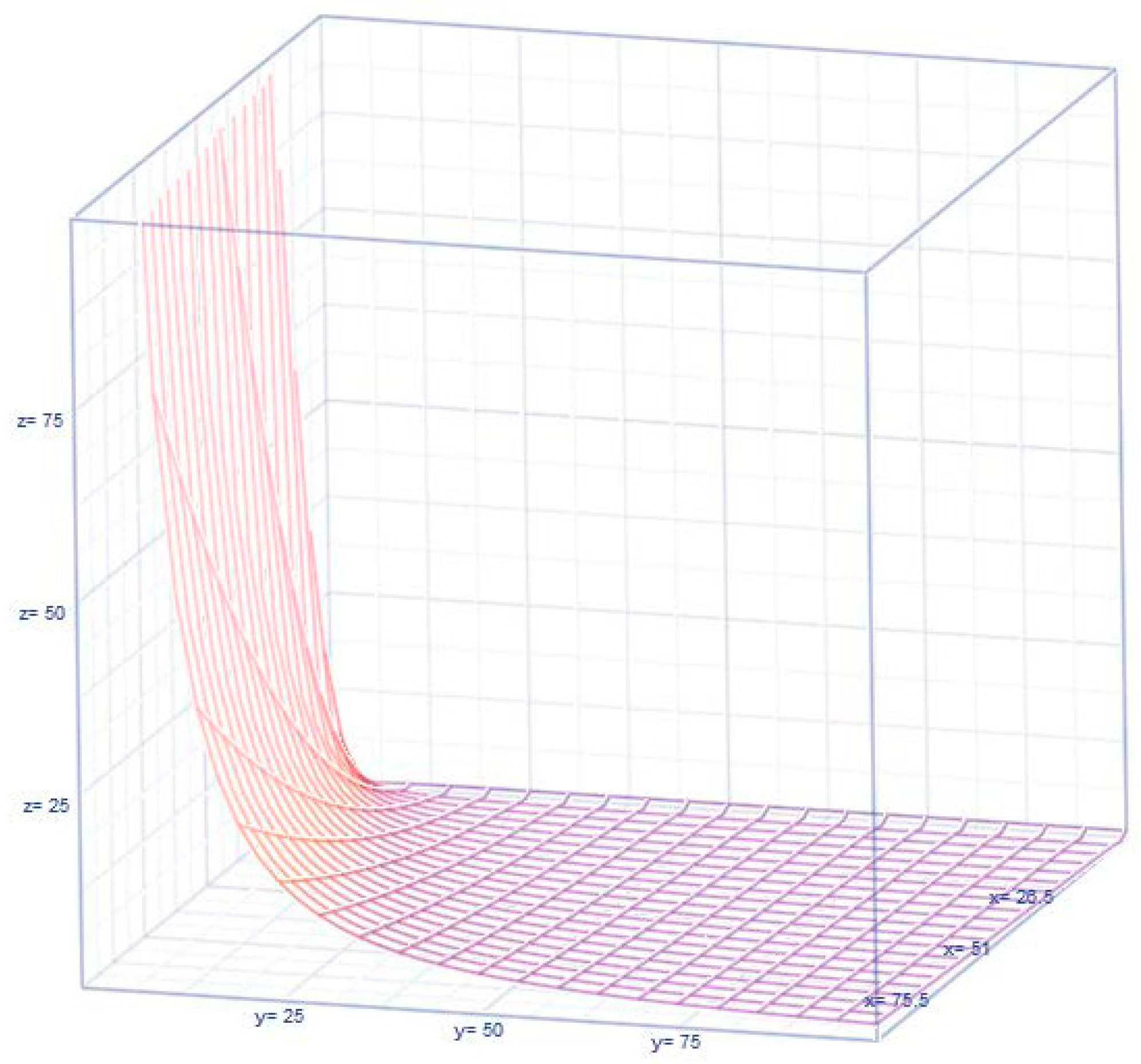

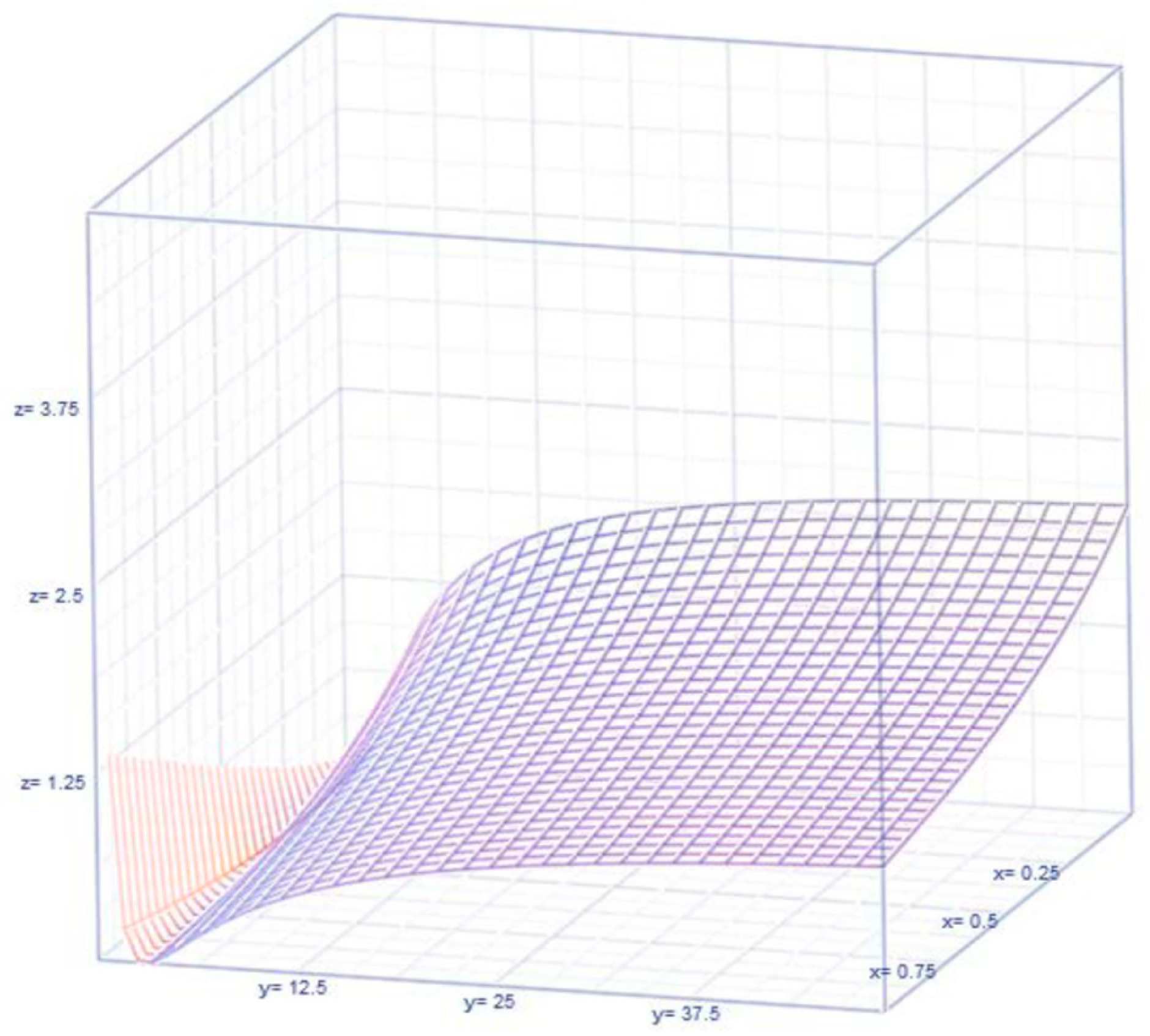

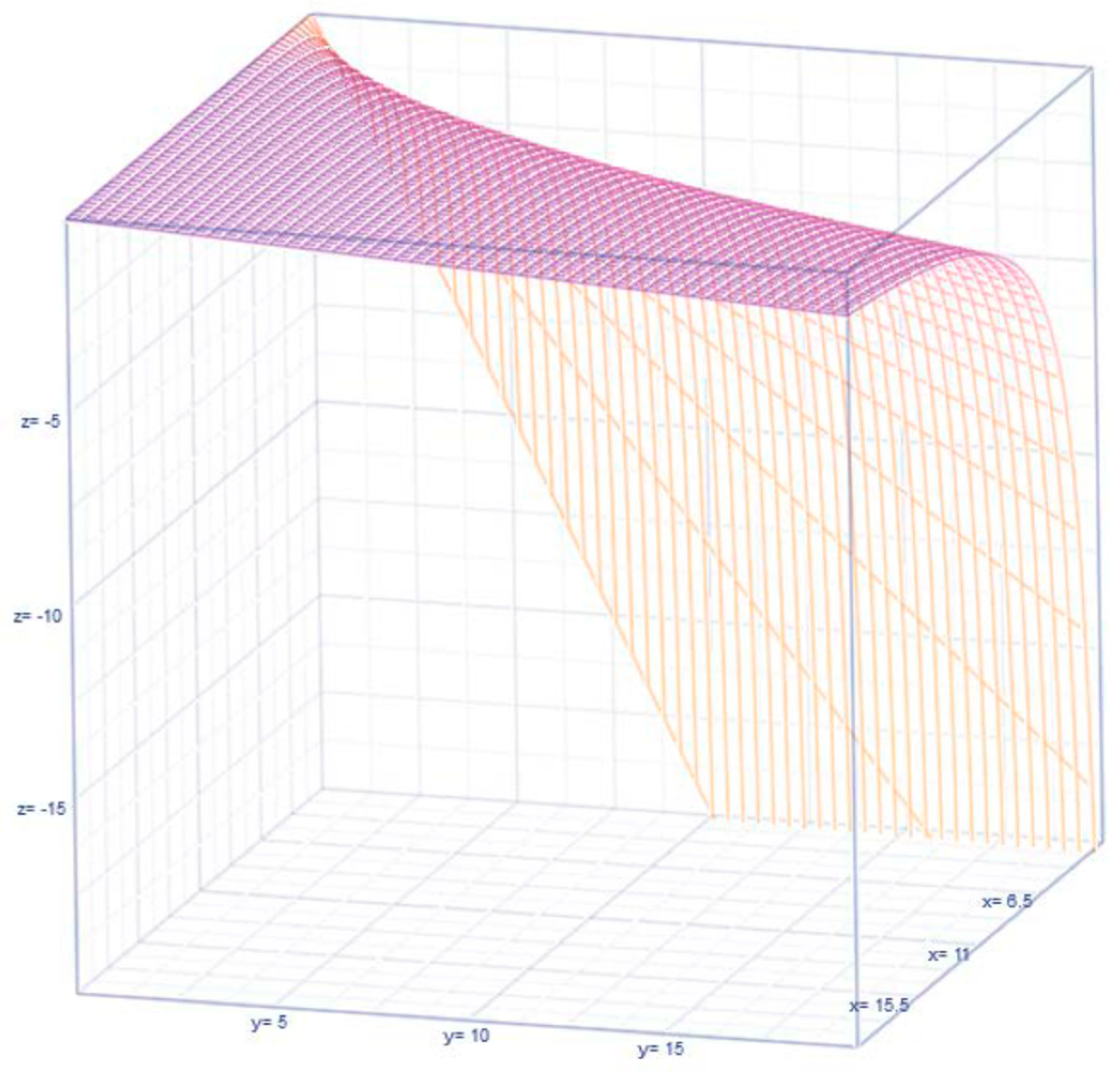
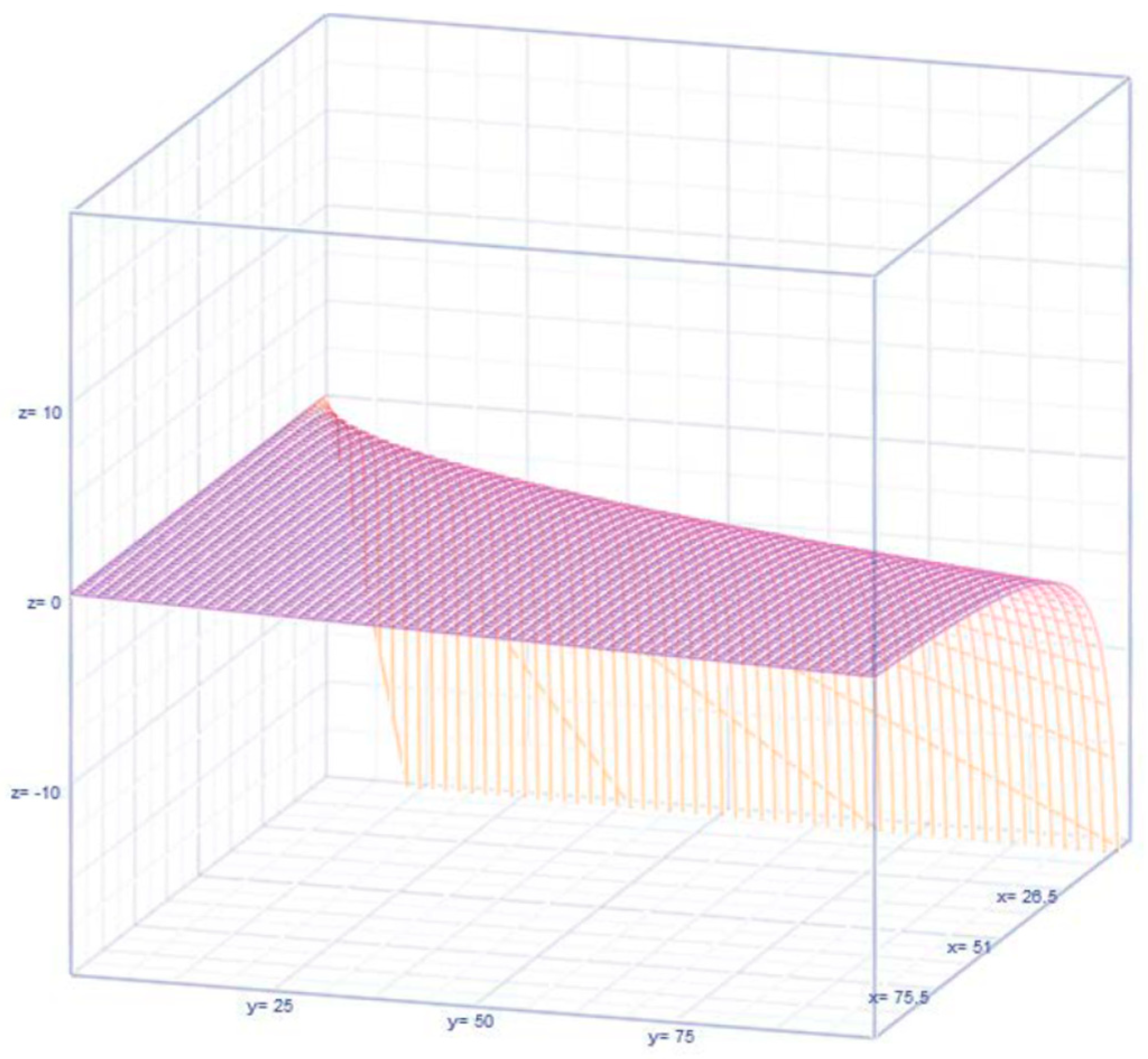


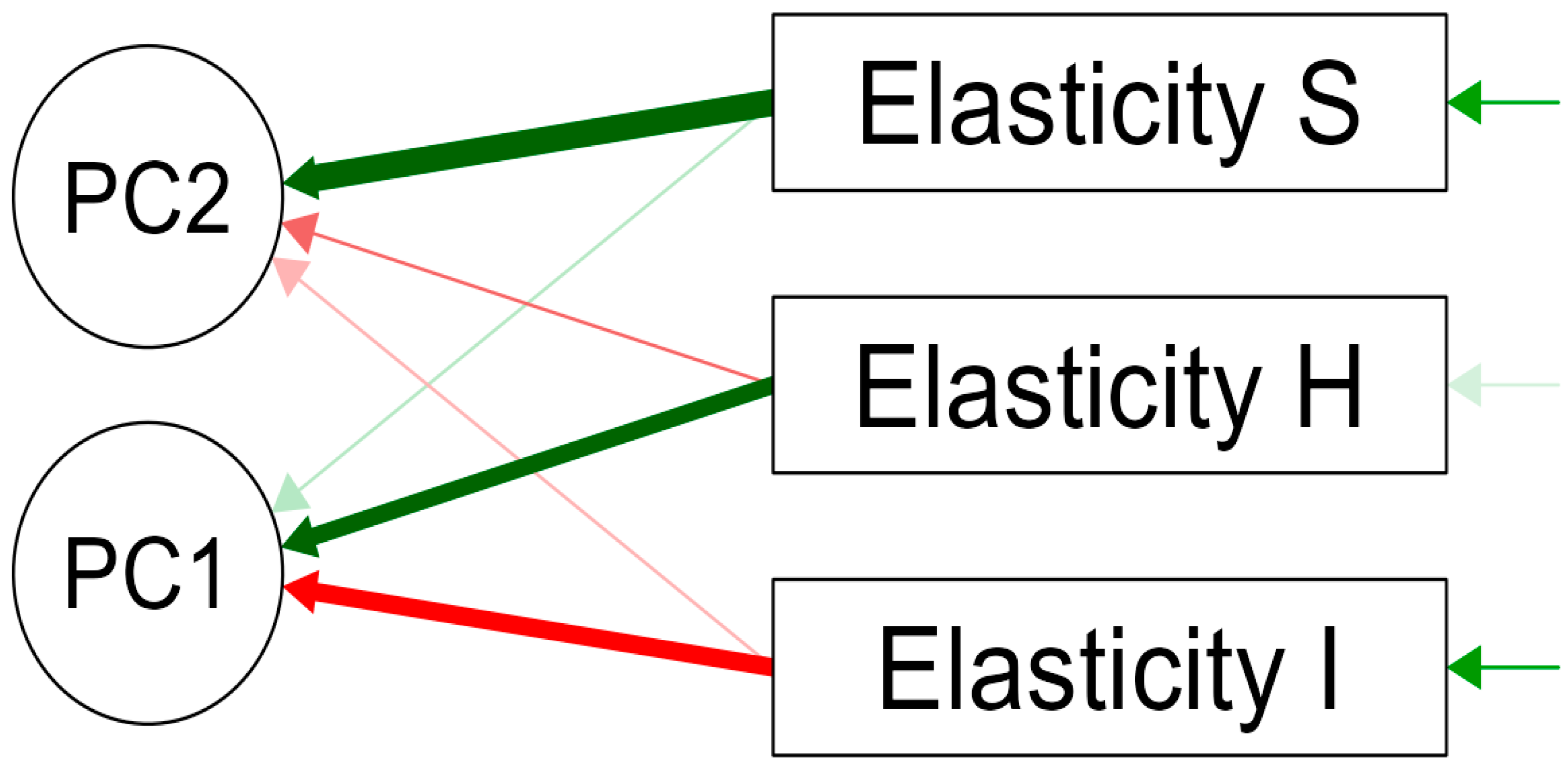
| Descriptive Statistics | |||||||
|---|---|---|---|---|---|---|---|
| Elasticity | N | Mean | Std. Deviation | Skewness | Kurtosis | ||
| Statistic | Statistic | Statistic | Statistic | Std Error | Statistic | Std Error | |
| 287 | −3.2622 | 3.46361 | −9.074 | 0.144 | 103.164 | 0.287 | |
| 287 | −2.1067 | 0.72007 | −9.164 | 0.144 | 119.002 | 0.287 | |
| 287 | −115.0829 | 1009.33736 | −14.102 | 0.144 | 215.831 | 0.287 | |
| Correlations | ||||
|---|---|---|---|---|
| Elasticity | ||||
| Elasticity | Pearson Correlation | 1 | −0.153 ** | −0.040 |
| Sig. (2-tailed) | 0.010 | 0.503 | ||
| Elasticity | Pearson Correlation | −0.153 ** | 1 | −0.022 |
| Sig. (2-tailed) | 0.010 | 0.715 | ||
| Elasticity | Pearson Correlation | −0.040 | −0.022 | 1 |
| Sig. (2-tailed) | 0.503 | 0.715 | ||
| Rotated Component Matrix a | ||
|---|---|---|
| Component | ||
| 1 | 2 | |
| Elasticity for I score | −0.752 | −0.189 |
| Elasticity for H score | 0.766 | −0.176 |
| Elasticity for S score | 0.006 | 0.972 |
Disclaimer/Publisher’s Note: The statements, opinions and data contained in all publications are solely those of the individual author(s) and contributor(s) and not of MDPI and/or the editor(s). MDPI and/or the editor(s) disclaim responsibility for any injury to people or property resulting from any ideas, methods, instructions or products referred to in the content. |
© 2025 by the authors. Licensee MDPI, Basel, Switzerland. This article is an open access article distributed under the terms and conditions of the Creative Commons Attribution (CC BY) license (https://creativecommons.org/licenses/by/4.0/).
Share and Cite
Shanmugam, R.; Singh, K.P. A New Measure for an Acceptable Level of Homogeneity in Meta-Informatics. Mathematics 2025, 13, 1364. https://doi.org/10.3390/math13091364
Shanmugam R, Singh KP. A New Measure for an Acceptable Level of Homogeneity in Meta-Informatics. Mathematics. 2025; 13(9):1364. https://doi.org/10.3390/math13091364
Chicago/Turabian StyleShanmugam, Ramalingam, and Karan P. Singh. 2025. "A New Measure for an Acceptable Level of Homogeneity in Meta-Informatics" Mathematics 13, no. 9: 1364. https://doi.org/10.3390/math13091364
APA StyleShanmugam, R., & Singh, K. P. (2025). A New Measure for an Acceptable Level of Homogeneity in Meta-Informatics. Mathematics, 13(9), 1364. https://doi.org/10.3390/math13091364






